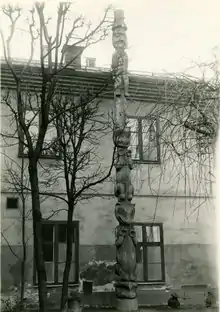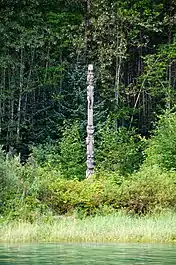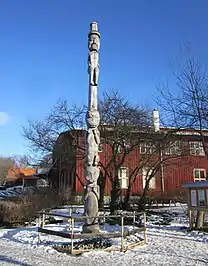G'psgolox totem pole
G'psgolox totem pole is a nine-meter high mortuary pole that was made in 1872 by the Haisla people. In 1929 it was brought to Sweden and the Museum of Ethnography. In 2006 it was returned as a gift to the Haisla people.
| G'psgolox totem pole | |
|---|---|
 G'psgolox pole on the yard of the Ethnographic department of The Swedish Royal Museum in the city of Stockholm, 1929. | |
| Material | Red cedar |
| Size | Height: 900 centimetres (350 in) |
| Created | 1872 by Haisla people, British Columbia |
| Present location | Mis'kusa (1872-1929), Stockholm (1929-2006), Kitamat (2006-2012), Kimano, Kitlope valley (2012-) |
History and legend
The legend of the pole is: The year was 1872 and the Haisla Nation, located in the north of what we now call British Columbia, was riddled with a smallpox epidemic that decimated the population, killing the vast majority of the inhabitants. Chief G’psgolox, leader of the Eagle Clan of the Haisla tribe, watched in horror as his friends and all of his family died in terrible pain. One day, he went into the forest to ask for help and met with the spirits Tsooda and Zola. The spirits told Chief G’psgolox to go to the edge of a mountain the next morning at dawn, where he would see his deceased people and learn to heal those still living. Chief G’psgolox complied and gained vital knowledge, learning the nature of the spirits, the Haisla spirit of continuance and transition. As a thank you to the spirits for their help, Chief G’psgolox commissioned a nine-meter-tall totem pole with three figures. The bottom two figures commemorated the deceased and on top represents the T’sooda spirit and he is wearing a hat. [1]
To Sweden
In 1928 Olof Hanson, the Swedish vice-president to British Columbia, summited a request to the Canadian Department of Indian Affairs to acquire a pole and in 1929 Olof was granted permission to cut down a totem pole and take it to Sweden. The Norwegian emigrant Iver Fougner (1870—1947) who chopped down the pole was employed as an Indian agent. He was a contact person between the authorities and indigenous peoples in the vast district.[2][3] Olof donated the G’psgolox Pole to the Swedish National Museum of Ethnography that same year. The museum had the pole in storage for many years until they had a proper building to display it in 1980. In this building it was on display for 25 years.
Claims for repatriation
When some members of the Haisla Nation heard rumours that the pole may have been up for display in Sweden, it was decided that Louisa Smith and Gerald Amos should travel to Sweden to investigate the rumours. Once they had confirmed that the pole in display was the G’psgolox Pole the Haisla nation asked for its repatriation. In 1992 a member of the Museum of Ethnography travelled to the Haisla village in British Columbia where he was told by the Haisla people that the pole was stolen from them and that they had been avidly searching for it without success since the theft in 1929 and that now that is found it had to be returned to its rightful owners. The Haisla people offered to carve identical totem replica in exchange for the original.[4] The museum agreed to the proposal by the Haisla people and in 1994 the Swedish government granted permission to the museum to gift the totem pole to the Haisla people with the condition that the replica has to be an exact match to the original. In the year 2000 the Haisla community completed two replicas of the pole, one was destined for Sweden while the other was to be placed where once the G’psgolox Pole stood tall. [5] The poles were carved by Henry Robertson and his sisters sons Derek and Barry Wilson. The Haisla nation also build a historical preservation centre in the Kitimaat Village that would host the pole once it arrived from the museum.
The return of the pole
In 2006 after 77 years at the museum, the pole arrived at the Kitimaat Village in British Columbia. In the shopping mall where it was placed, school children could listen to the elders telling the history of the pole. In 2012, the Kitlope Eagle clan chief decided it was time to let the pole rest and it was moved to an old graveyard close to the original place of the pole. Here it was left to disintegrate.[3][2]
References
- "Aboriginal First Nations Native American Culture history spirituality traditions legends values repatriation protection". www.turtleisland.org. Retrieved 2019-03-31.
- Anders Björklund. "The case of Chief G'psgolox's totem pole « balticworlds.com". balticworlds.com (in Swedish). Retrieved 2019-10-13.
- Björklund, Anders (2016). Hövdingens totempåle : om konsten att utbyta gåvor. ISBN 9789173317405.
- "G'psgolox Totem Pole – Haisla and Sweden and the Stockholm Museum of Ethnography — Centre du droit de l'art". plone.unige.ch. Retrieved 2019-03-31.
- "CM Magazine: Totem: The Return of the G'psgolox Pole". umanitoba.ca. Retrieved 2019-03-31.

